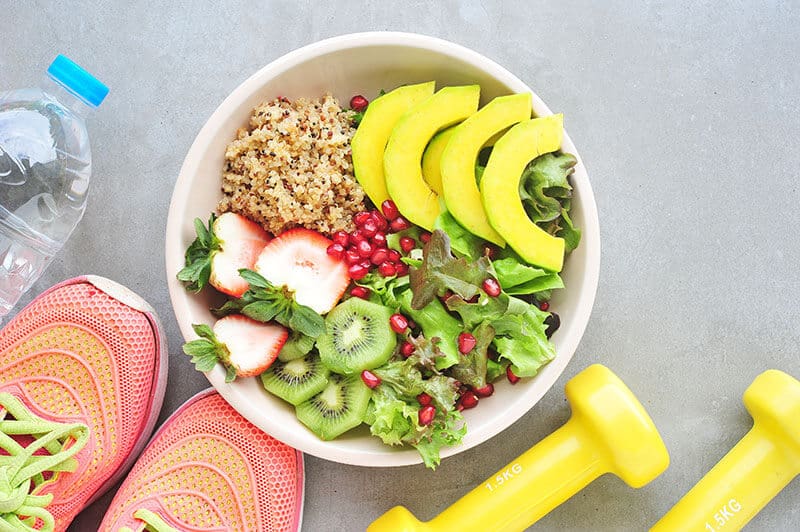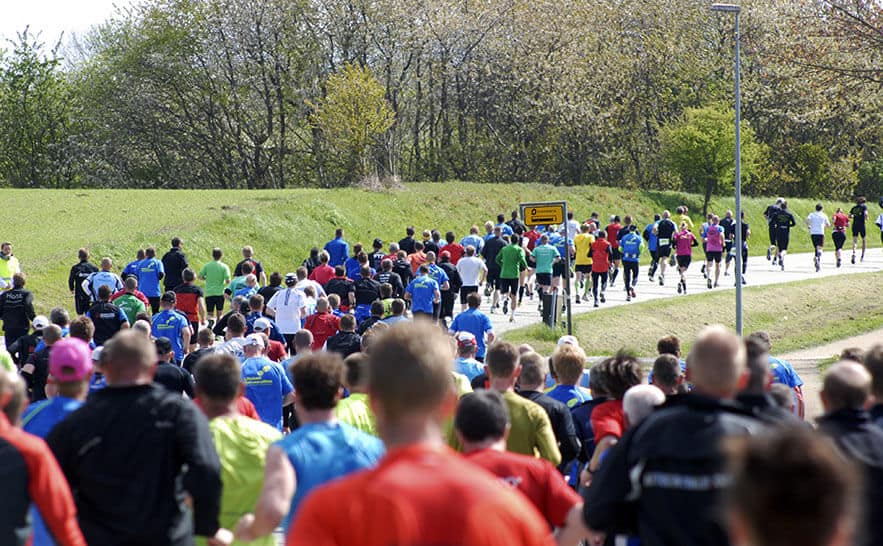At school, the subject I hated most was physical education. And the most hated exercise in that course was running – around the gym or on the street, and passing the minimum requirements, of course. This year, I’m 32 years old, and just recently, for the first time in my life, I ran 22 kilometers without stopping. I ran relatively easily and with great pleasure, and I am glad to tell you how I managed to achieve this.
What you need to know before you start
The basic rule is: getting to 22 or 43 kilometers immediately, without having gotten into the proper physical shape, is absolutely impossible.
But if you have firmly decided to commit yourself to intelligent training, keep in mind the following:
- You will need a trainer– a competent person who will periodically give you a kick and develop a good training program. It is desirable that he himself has had the experience of running in competitions.
- You’ll have to learn to love strength and interval training at the gym. In order for the body to help, and not interfere during your run, you must provide it with appropriately developed muscles
- Training will become a completely integrated part of your new lifestyle, and not an indulgence reserved for good weather and the right mood, when you have some time.
- Training will take a lot of time, and the further you go, the more time it will take (up to three or four hours a day)
- You will have to invest in classes and a high-quality outfit. The further you go with this, the more you will achieve.
- It will quickly become clear that you don’t know your body at all and normally do not control your breathing or your extremities as you should. And your nervous system, it will turn out, is naughty. You will have to get to know each other again, or maybe for the first time.
- You will experience pain and discomfort in the process of training. Still, twenty-two or more kilometers – by any reckoning, this is a lot more than five kilometers.
- You’ll have to adjust your sleep and nutrition and try to arrange days of chaos as rarely as possible.
- Smoking and running are incompatible.
- Alcohol, coffee and energy drinks are compatible with an effective training regime, but in very moderate and reasonable doses.
- Before getting serious, it is desirable to undergo a full examination by a doctor, including a complete blood analysis.
- Vitamins and supplements will significantly improve your overall condition, if you take them regularly and on the recommendation of a doctor.
- As the competition draws near, you will have to adapt the schedule of each day to the training regime, and not vice versa.
The training mode
The training mode for a marathon is an individual thing, but on average it looks like this: between 2 to 3 cross-country workouts and 1 to 2 strength / interval workouts per week. The regime should be designed so that you have enough time for rest and muscle recovery between workouts.

Do not train:
- during illness
- during 1 to 2 days of the menstrual cycle (even if you are not experiencing severe pain)
- if you feel you are barely able to walk after your previous workout
- if there are acute pain symptoms anywhere in your body
- if you are very sleepy
- immediately after eating or on an empty stomach
The correct time for training is one-and-a-half to two hours after eating, preferably during your “active” time of day. The right hours for training activities will become clear with experience. If you are a night owl, then early runs will almost certainly be a test of strength for you. Conversely, training at dusk can be tedious for the “larks”. Since you will have to rely on willpower, and it is necessary to do so, you should make your life easier, at least with respect to your personal scheduling.
The plan for running workouts should include short and long workouts. For example, if you run three times each week, then you should undertake 2 short runs and 1 long run. At the same time, the duration may change from week to week: in one week you might run the easier and shorter distances, the next – the more difficult ones, and after a week you may “rest” again.
Strength training plan should be consistent with your over-all plan. If you have a tense “running” week, then it would be logical to work in the gym on your upper body and give a break to your legs, and vice versa.
The most unpleasant part of your preparatory work will prove to be interval training, which teaches the body to work even when it already seems impossible to take a single step, to recover as soon as possible, and to work again. It is better to conduct such classes under the supervision of a trainer — I don’t know anybody who could manage to squeeze himself voluntarily by 250 percent.
On the way to optimal nutrition
In order to get individual recommendations, you should visit a nutritionist. However, there are general rules that all runners should follow.

- While running, the body uses nutrients from food, but not from the food that came to it two hours ago at lunch or dinner, but from the food that was ingested yesterday. Therefore, the runner’s diet will have to be followed consistently.
- A hard diet with a complete ban on carbohydrates or their minimization are strictly out of the question.
- Fats– referring to the healthy fats found in nuts, cheese, vegetable oils, avocados, fish – they are an important source of energy for a runner. Women athletes need them especially.
- Fast food, fatty, and fried foods should be excluded for two reasons (not to mention the fact that they do not, in general, facilitate a healthy lifestyle). Firstly, the body digests fats very slowly, therefore they complicate the function of the digestive tract, which means that a runner who maintains a fatty diet will have less strength for training. Secondly, all the nutrients in fatty items have already been destroyed by severe heat treatment.
- Your diet should be designed with a view to the purpose you have in running. If you want to lose weight, then the rule is: “Eat fewer calories than you burn.” In addition, you must strictly control the amount of fat in the food you eat, limiting your intake of complex carbohydrates (potatoes, cereals, pasta) for a couple of hours before your workout and staying away from high-carb cocktails. After making up the carbohydrate deficiency that you will experience after jogging, then you should lean on high-protein foods – not only to provide the building material for muscle tissue, but also to create the necessary energy deficit for the body, so that it will have to use its own fat reserves.
- During active training, the body loses not only calories, but also salt and trace elements. A lack of vitamins and minerals can manifest itself in a feeling of general fatigue, dizziness, pain and muscle cramps and so on. Taking a single vitamin supplement will not correct the situation – the body needs balance. And you should keep in mind that there are some vitamins that are especially important: Fe, Ca, K, Mg, Na, Zn, Cu, Cr. Vegetarians should regularly check the level of Fe in the blood, since the main source of iron is red meat, which is not available in a vegetarian diet. If you haven’t researched vitamins yet, then at least try to eat as „colorfully“ as possible and not overcook vegetables, so they will bring maximum benefit to the body.
- Long-term aerobic training is a kind of stress regimen for the body that promotes the formation of free radicals (we hear about them from advertising for cosmetics). If there are not enough antioxidants in the body to can fight them effectively, then free radicals will start attacking the cells of the body. Vitamins C and E, carotenoids, selenium and zinc have strong antioxidant properties, therefore the runner’s diet should contain citrus fruits, kiwi, tomatoes, broccoli, cauliflower, sweet peppers, potatoes, nuts, seeds, leafy greens, spinach, eggs, carrots, onions, garlic (and meat – if you are not a vegetarian).
Nutrition during exercise
Even if your goal is to lose weight, it does not mean that you have to, through a triumph of self-discipline, run 20 kilometers without taking a single poppy seed in your mouth. The success of the runner depends on replacing in time those substances that the body loses along with sweat (see the previous paragraph on nutrition). To do this, you need to drink fluids regularly and gradually without waiting for thirst (about once every 20 minutes), and support the body with foods with a high glycemic index (fast-absorbing carbohydrates).
Today, there are many special isotonic drinks with a thoughtful combination of ingredients and sports carbohydrate gels. However, if you have diseases of the gastrointestinal tract, these products may, unfortunately, be poorly absorbed or cause discomfort during the digestive process. A safe option is to prepare a solution for drinking for yourself: dilute 1-2 teaspoons of table salt in a liter of drinking water, add lemon juice and honey to taste, and mix well.The resulting mixture can not be called tasty, but in practice it justifies itself better than any sports drink in the stores. Instead of sports gels, buy some combination of honey and soft dates, which you cannot chew, but allow to dissolve slowly.
You mustn’t do this:
- Drink just clean water during a long run – it only worsens your general condition.
- Use an excessive amount of energy products during a short run (up to 30 minutes, about 5 km) or immediately before the start.
Other tips
Before the start of a sports “career” you may have been able to work without stopping, sleep for three hours, and not have a weekend. Once you begin preparing for a marathon, however, you cannot live this way anymore.

Rest can be more or less active. Active options include changing activities – for example, skating or skiing in the winter, swimming in the summer, or just a measured two-hour walk. Options for a measured rest that will be very effective for the body include: stretching, hatha yoga, massage, sauna, bath, pool, and normal sleep. Runners should sleep at least eight hours (you will quickly feel the effects yourself), in a well-ventilated and comfortable room.
In order not to miss “sessions” of rest and control the duration of sleep, it is useful to keep a diary of training and nutrition.
It is worth keeping track of: the number and duration of classes, the results of your heart rate monitor (pulse, calories, kilometers, speed, time), your health status (fatigue, any pain, malaise at different periods of the cycle in women, insomnia, etc.), the number of meals and the composition of the menu, as well as deviations from the regime / diet (honestly!) and other details that seem important to you (“ran in new sneakers”, “changed the technique of running”, “very bad weather for training”, etc.) .
Note 1:
One of the most common unpleasant symptoms when running is pain in the right or left side. It occurs for several reasons: you have not taken a sufficient break after eating; you are breathing incorrectly; you are running too fast; or your abdominal muscles are not sufficiently trained, and when running, they do not sufficiently support abdominal organs, protecting them from shocks.
The result is pain.
Note 2:
Even if you take everything into account, so that neither hunger nor pain symptoms arise, at some point you may still feel: “Okay, I’m done, I can no longer run, I can not stand it!” Usually these thoughts come after twenty and more kilometers. Remember that in addition to muscles and bones, we still have brains and psyches – it is mental overstrain that can prevent an athlete from reaching the finish line. The brain, frightened by the number of kilometers on the sports tester, will start sending you pseudo-fatigue signals. Remember that all barriers are only in your head, you can do anything you can afford. Therefore, spend the day on the eve of the competition as calmly as possible and get enough sleep — in the middle of the race your nervous system will be grateful to you. In the process of running, treat your body as if it were a normal mechanism: after all, when you run out of fuel in your car, you don’t get psychotic, or turn back or cancel the ride, right?
You just stop, refuel, and move on to the goal.
Other little things that are not really that little
After observing the training regime for a long time – and learning exactly what happen as you prepare for the marathon – and finding that it is not easy, try to make your life easier where it is possible.
- Get comfortable sportswear for all the weather conditions in which you have to train. An important consideration for girls: comfortable and beautiful clothes! If you ever run in the cold and wind, then at least have a bright and cool jacket.
- If you run in any weather, then make sure that the outerwear has reflective elements. There are many sad stories about drivers who did not notice the runner in the fog on time and did not manage to brake.
- Quality sneakers do not necessarily cost a million, but you must consult with a knowledgeable person before purchasing them. This can be either an experienced salesperson or a friend who has had experience in running. A rather versatile and “hardy” line of shoes for long-distance running.
Aspects that play a role when choosing shoes:
- body weight
- foot size
- the number of workouts per week
- the number of kilometers per week
- the intensity and speed of each run
- your running style: what is the first thing that touches the ground, the heel or the toe?
- The presence or absence of flatfoot
- The presence of pronation or supination
- the surface you most often run on
Running shoes will always be about a size and a half larger than the shoes you wear in everyday life. The fact is that during movement the leg slides a little forward, and it needs space for it.
Consultation with an orthopedist will be a good prevention of unwanted problems with the feet. Perhaps he will advise the use of orthopedic insoles – then it is better to order them for the specific sneakers in which you plan to train.
Another preventive method is to consult a trainer who will adjust your running technique and point out errors. The improper running techniques that often distinguish beginners can lead to injuries to the ankles and knees.
At the initial stage of training, you should buy a sports tester. With it, it is very convenient to track not only mileage, time and speed, but also your pulse. Running on an average pulse is considered one of the most effective ways to compete, if we are not talking about interval training.
Running speed can be determined without a heart rate monitor, intuitively. So, if you are able to say no more than one or two phrases while running, without knocking down the breathing rhythm, you feel good, but you feel a certain load – then you are running in a good training rhythm.If you still want to know your limits exactly and need indicators (for those who are preparing for competitions, this is not superfluous), then it is necessary to pass an examination in the laboratory on a running simulator under the supervision of specialists.
Since in the process of running you will eat and drink (see earlier), it is worth buying a special belt, vest or backpack for stocks. The belt is suitable for shorter distances, a backpack, on the contrary, for longer ones. Modern running backpacks are equipped with a convenient system for drinking: tanks with liquid are placed behind the runner’s back, and a tubule is taken out of them, through which you can quench your thirst at any time without stopping. In addition, such a backpack will also include clothing in case of bad weather.
Even if you dislike sunglasses in everyday life, they will come in handy in training for running, especially for those with sensitive eyes or for contact lens wearers.
And finally …
No matter how much you want to conquer the Olympic distance, it may happen that, according to medical indications, running, at least with a serious workload, will be contraindicated to you.

If you have not been to a doctor, answer the following questions for yourself:
- Has a doctor ever mentioned that you have heart problems?
- Do you occasionally feel pain in your heart or chest?
- Do you feel weak or nauseous without a reason?
- Has the doctor ever noticed that you have high blood pressure?
- Do you have arthritis or its symptoms?
- Do you have a serious health problem that would be an obstacle to running? Warning: overweight is not a reason.
- Are you 40 years old or older? Have you been involved in sports in the past two years?
If you are less than forty years old and you lead a fairly active lifestyle, and you answered negatively to the previous questions, then there are no visible contraindications for jogging.
When can a doctor still ban you?
- Congenital or acquired heart defects
- Acute myocardial infarction
- Severe heart rhythm disorders
- Artery disease
- Acute gastrointestinal diseases
- Acute embolism
- Acute inflammation of the veins
- Acute inflammation of the liver
- Acute infectious disease
- Hypertension
- Severe arthritis
- Other serious diseases (diseases of the nervous system, cancer, etc.)
But let’s not talk about sad things. Cheers – and let the next marathon be yours!
Photos: Shutterstock
Support us!
All your donations will be used to pay the magazine’s journalists and to support the ongoing costs of maintaining the site.
Share this post
Interested in co-operating with us?
We are open to co-operation from writers and businesses alike. You can reach us on our email at [email protected]/[email protected] and we will get back to you as quick as we can.









